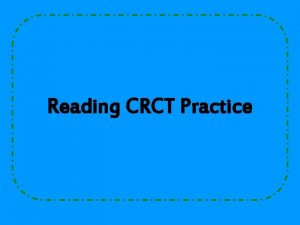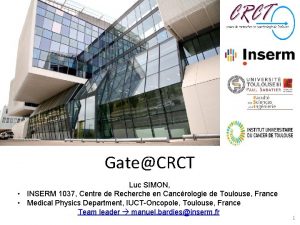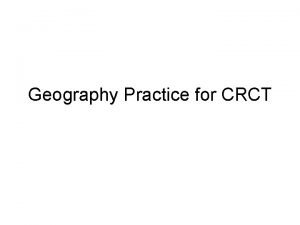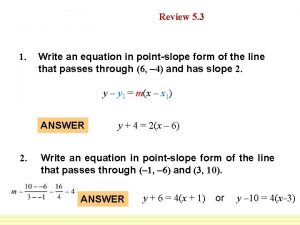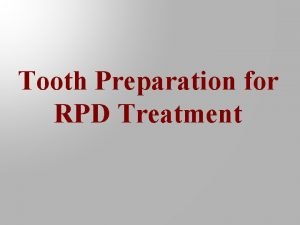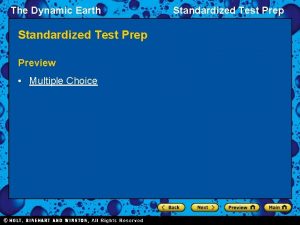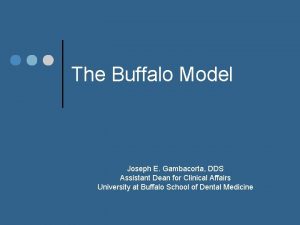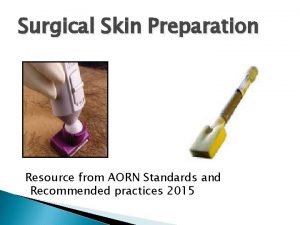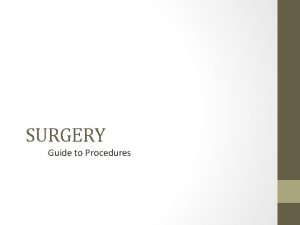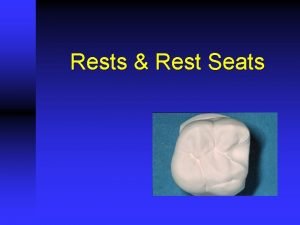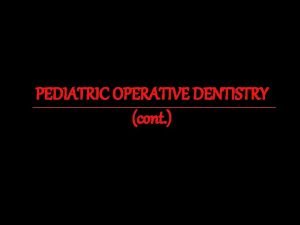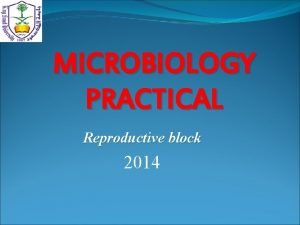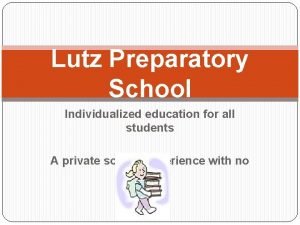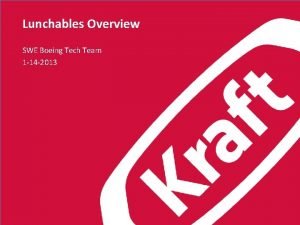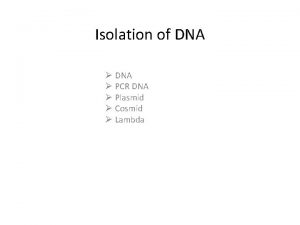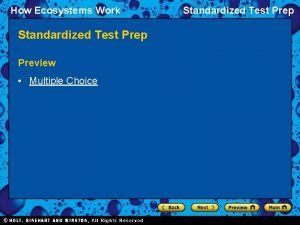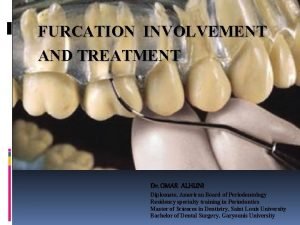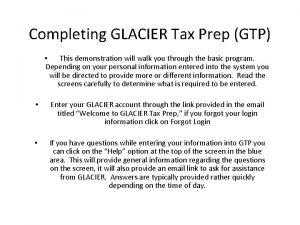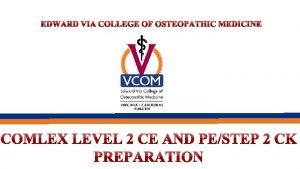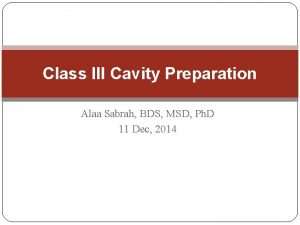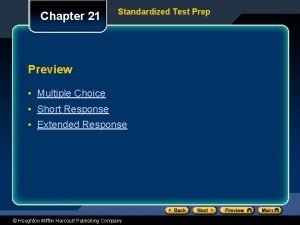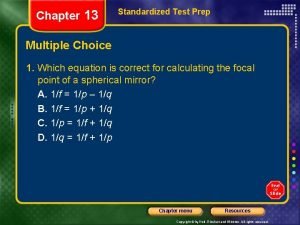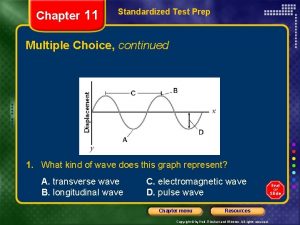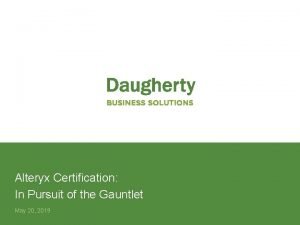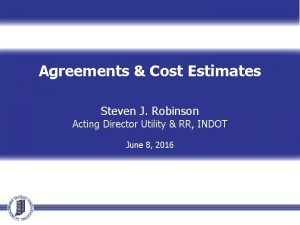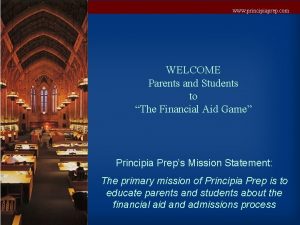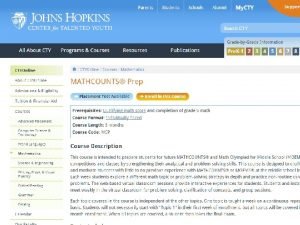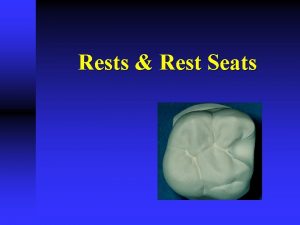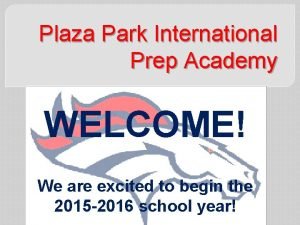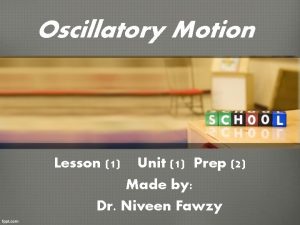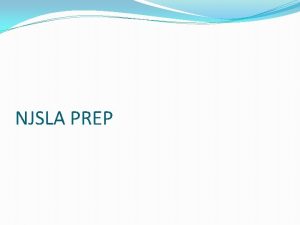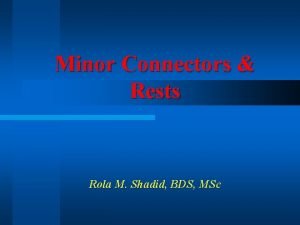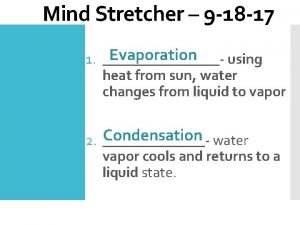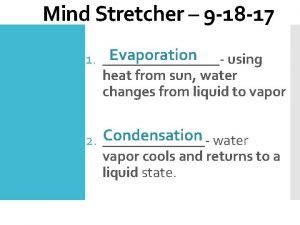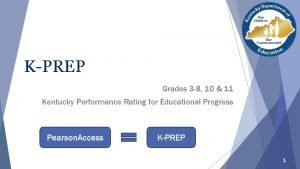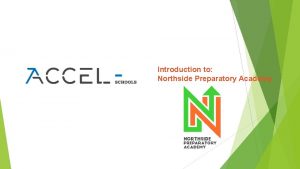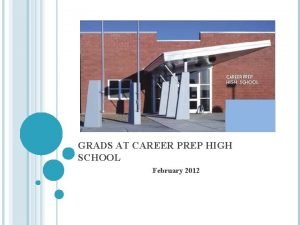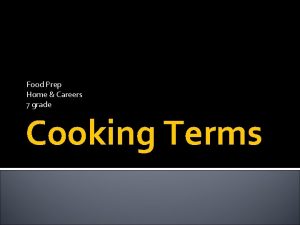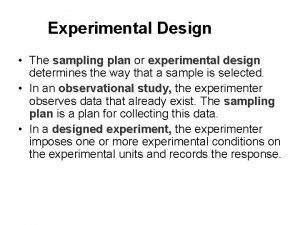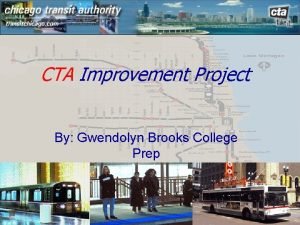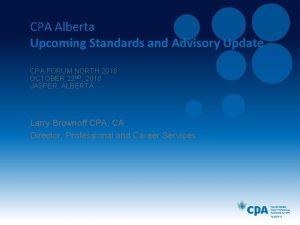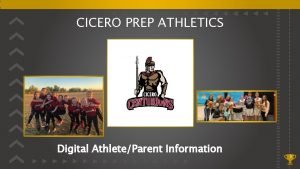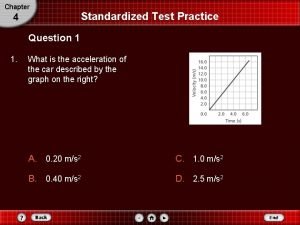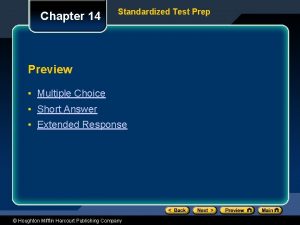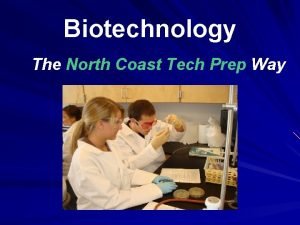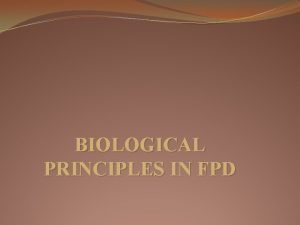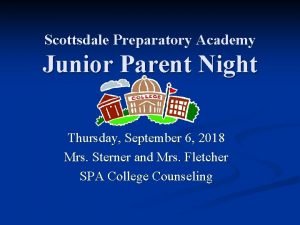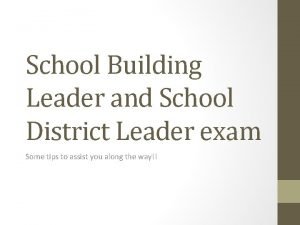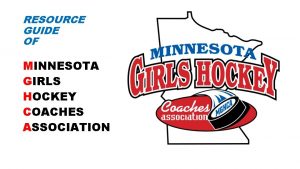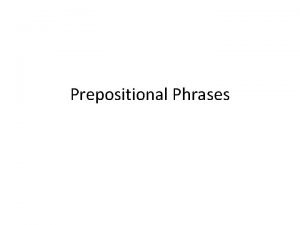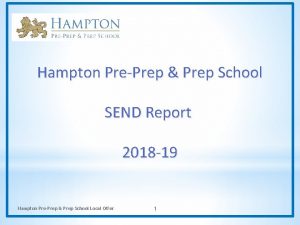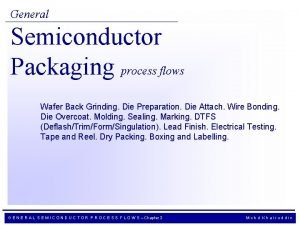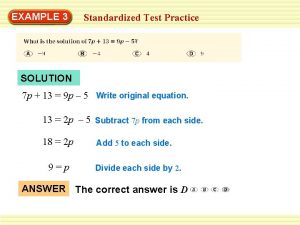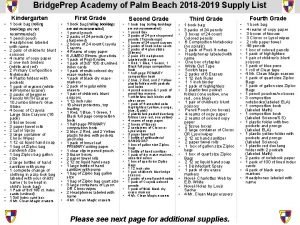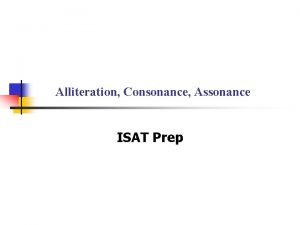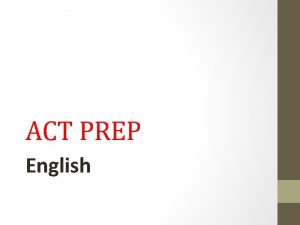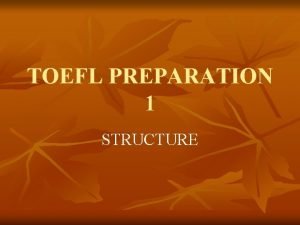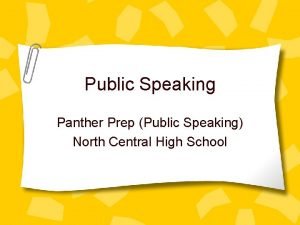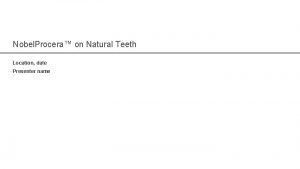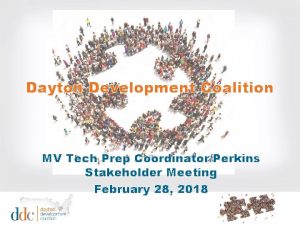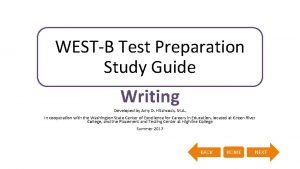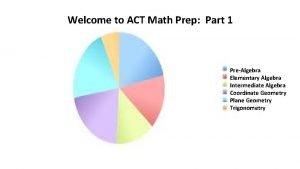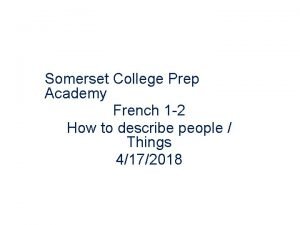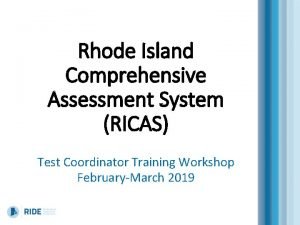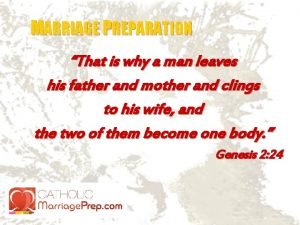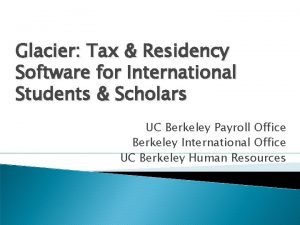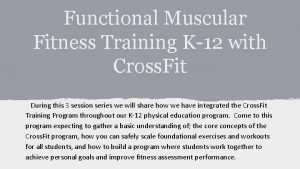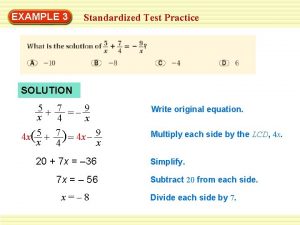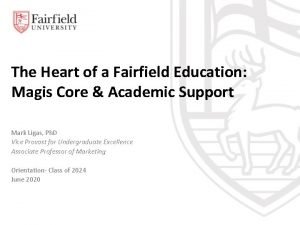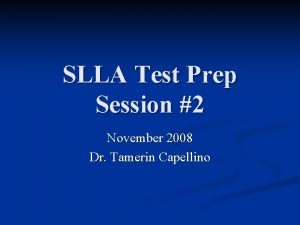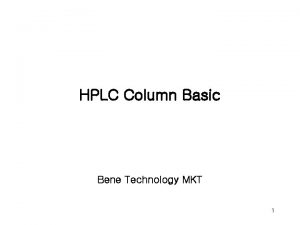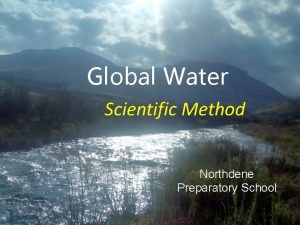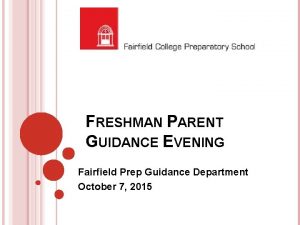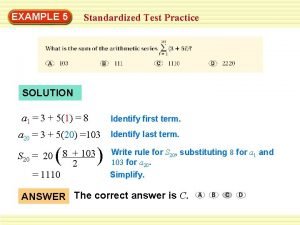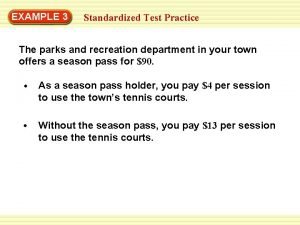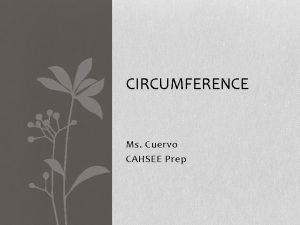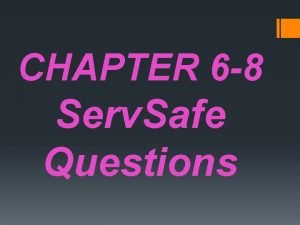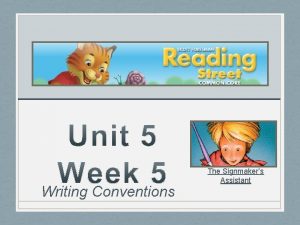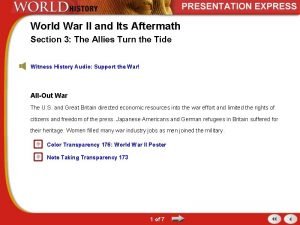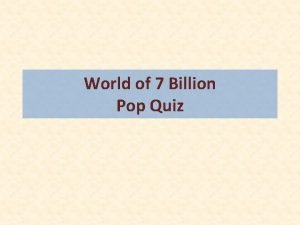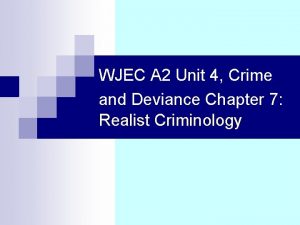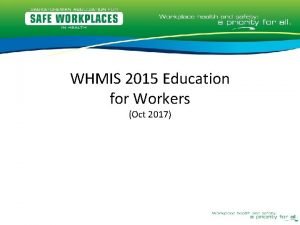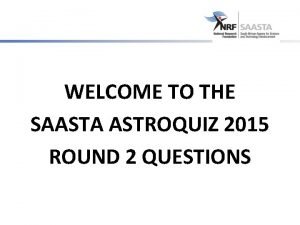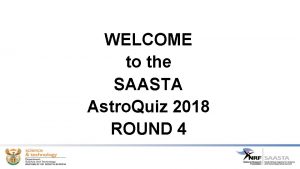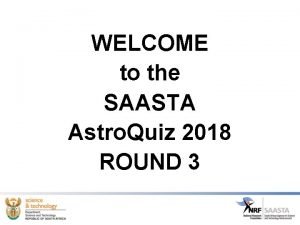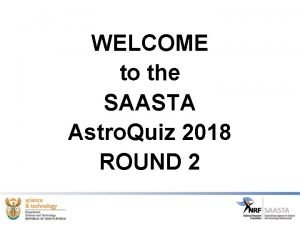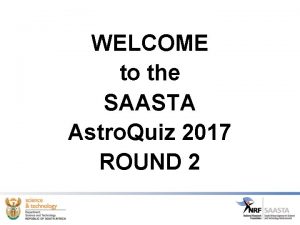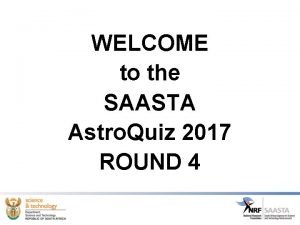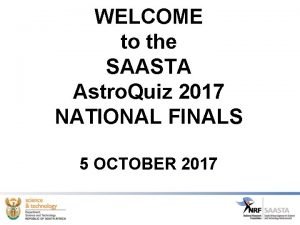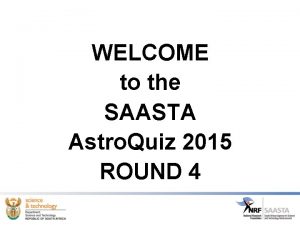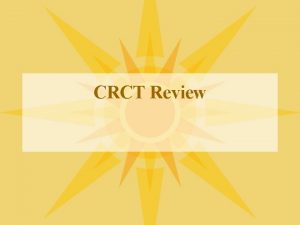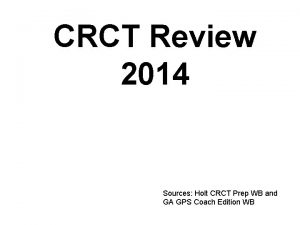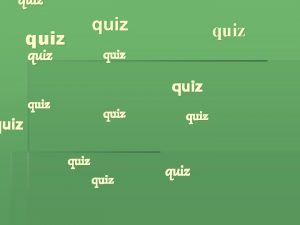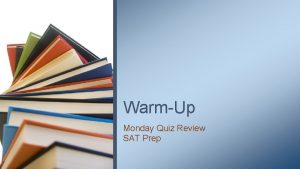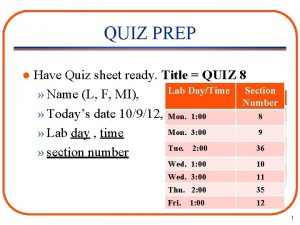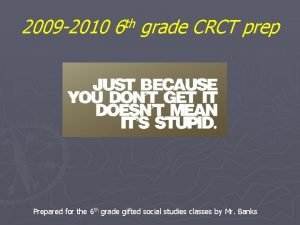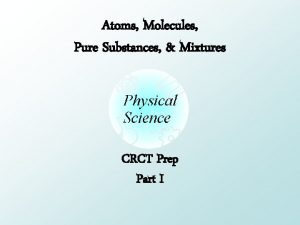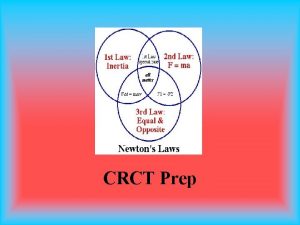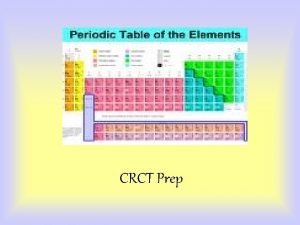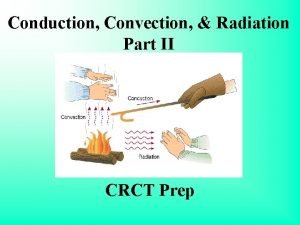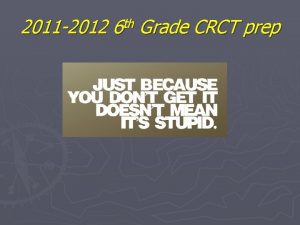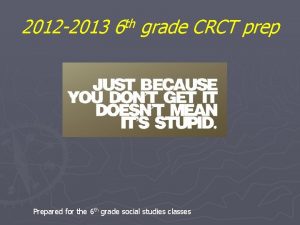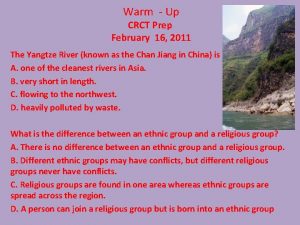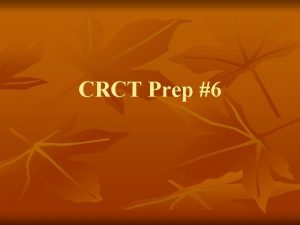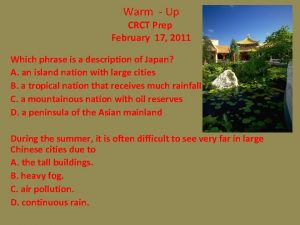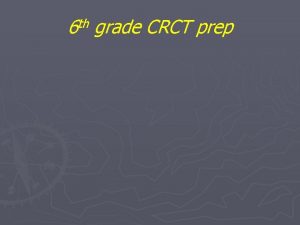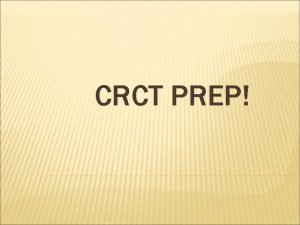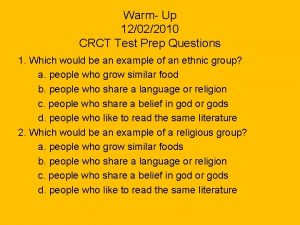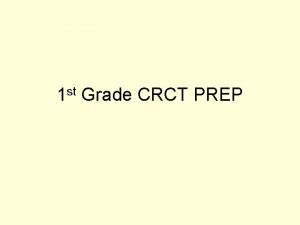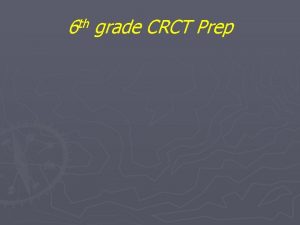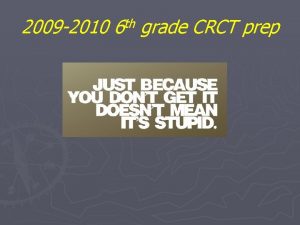CRCT Review CRCT Prep Quiz 1 l S



















































































































































- Slides: 147

CRCT Review

CRCT Prep Quiz 1 l S 6 E 5 a. Compare and contrast the Earth’s crust, mantle, and core including temperature, density, and composition.

1. High temperatures inside Earth form a. Melted rock b. Fossils c. Soil d. Minerals

2. Which of these statements about Earth’s crust is true? a. It is a layer of solid rock that remains the same throughout time? b. It includes the continents, but not the ocean floor. c. It is a changing, moving surface with the same thickness everywhere. d. It is a system of large masses called plates that slowly move together or apart.

3. Compared to rocks in Earth’s crust, rocks in the mantle are more a. Dense b. Mineral-rich c. Granular d. Porous

4. The pie section shows Earth’s composition from the center to the surface. Section IV is most likely composed of a. Molten rock b. Granitic rock c. Solid iron d. basalt

5. A deep well or mine shaft goes through which layer or layers of Earth? a. Crust only b. Mantle only c. Crust and mantle d. Mantle and core

6. Earth’s core is mainly composed of a. Iron and aluminum b. Silicon and hydrogen c. Iron and nickel d. Silicon and oxygen

7. Scientists believe the Earth’s inner core to be solid. This is probably due to extremes in: a. Depth b. Density c. Pressure d. temperature

8. The average density of one of the continental crusts is 2. 8 g/cm 3 and the average density of one of the oceanic crusts is 3. 2 g/cm 3. If these two plates came together, what could be expected to happen? a. The two plates would push apart and form a rift zone. b. The oceanic plate would rise up over the continental plate. c. The oceanic plate would be pushed under the continental plate. d. The two plates would meet head on and rise up to form mountains

9. If we compare the temperature and pressure of the Earth’s mantle to the core, what differences can we expect as we move downward into Earth? a. Both the temperature and pressure increase b. Both the temperature and pressure decrease c. The temperature decreases and the pressure increases d. The temperature increases and the pressure decreases

10. Layer C in the diagram has the greatest temperature and pressure. It is MOST LIKELY Earth’s a. Atmosphere b. Crust c. Mantle d. Core

11. Layer A in the diagram has the lowest temperature and pressure. What part of Earth is labeled layer A? a. The atmosphere b. The crust c. The mantle d. The core

12. What is located beneath soil layers? a. Bedrock b. Humus c. Lava d. Tundra

CRCT Prep Quiz 2 l S 6 E 5 b-Investigate the contribution of minerals to rock composition.

1. Cleavage of a mineral is related to a mineral’s a. Chemical composition b. Streak color c. Luster d. Crystalline structure

2. Which is NOT part of the definition of a mineral? a. Naturally occurring b. Definite composition c. Solid d. Organic

3. Which is a mineral? a. Glass b. Graphite c. Magma d. marble

4. Granite is a kind of a. Energy b. Fossil c. Rock d. Mineral

Mineral Hardness Way it breaks Luster Streak color Galena 2. 5 Cleavage Metallic Gray-black Silver, gray Magnetite 6 Fracture Metallic Black Hematite 6 Fracture Metallic-dull Red-brown, silver, black Susan wants to identify a dark, heavy mineral sample. She notices there are three minerals in a chart reference book that might match her sample. Susan next observes that her sample has flat, reflective surfaces that break into boxlike steps. She infers that the mineral may be galena. If she is correct one more test will verify her inference. Which property would be best for her to observe next? a. Hardness b. Luster c. Streak d. Color

6. When limestone is exposed to enough heat and pressure, it goes through physical changes. These changes can turn limestone into a different kind of rock called marble. Which of these BEST describes marble? a. It is an igneous rock. b. It is a synthetic rock. c. It is a sedimentary rock. d. It is a metamorphic rock.

7. During a summer vacation in Hawaii, Carlos found several rock samples to share with his Earth science class. Most of the rocks were black, containing only a few light-colored crystals. All of the crystals were large and the rocks had a coarse texture. Based on this information which of the following statements is true about the rocks Carlos found? a. The rocks were obsidian b. The rocks were extrusive c. The rocks were intrusive d. The rocks were metamorphic

8. Limestone is a sedimentary rock found in South Georgia and North Florida. Limestone is easily weathered and eroded because the main mineral found in limestone reacts with acid rain and ground water. What type of mineral likely makes up limestone? a. Calcite b. Gypsum c. Quartz d. Silica

9. This intrusive igneous rock is dark in color and contains minerals that are high in iron and magnesium. Based on this information, what type of igneous rock is this? a. Slate b. Gabbro c. Obsidian d. Rhyolite

10. Students want to identify a rock in a nearby field. Which of the following properties would be most useful in identifying the unknown rock? a. Color b. Smell c. Mineral content d. Specific weight

CRCT Prep Quiz 3 l S 6 E 5 c- Classify rocks by their process of formation

1. What kind of rock is formed when volcanic lava cools? a. Sedimentary b. Metamorphic c. Igneous d. Magma

2. A student wants to study how igneous rock changes to sedimentary rock. Is this a good project if the student needs to complete the study within a month? a. Yes, because the changes will happen quickly and be significant. b. Yes, because the changes will be easily observed since they are very obvious. c. No, because the difference between igneous rock and sedimentary rock is noticeable. d. No, because the changes will take much longer than a month to occur.

3. Rocks found on Earth are generally classified as sedimentary, metamorphic or igneous. On which basis are these classifications made? a. Where the rocks are found b. How the rocks were formed c. The color and shape of the rocks d. The chemical composition of the rocks

4. The formation of metamorphic rocks depends on all of the following except a. The composition of the parent rock b. Earth’s magnetic field c. Temperature d. pressure

5. When rocks undergo weathering, they become a. Magma b. Igneous rock c. Sediment d. Volcanic cones

6. Sedimentary rocks can be converted into magma by undergoing which of the following processes? a. Weathering and erosion b. Cooling and crystallization c. Heat and pressure d. Compaction and cementation

7. What type of rock results from the cooling of lava from a volcano? a. Sedimentary b. Bituminous c. Igneous d. metamorphic

8. Igneous rocks are classified by where they are formed. Which type of igneous rock forms underground? a. Extrusive b. Intrusive c. Volcanic d. ash

9. Igneous rocks form from a. Sediment b. Mud c. Gravel d. Magma

10. Some of Earth’s rocks are formed by the cooling of a molten material called a. Magma b. Ore c. Coal d. Lime

11. What type of rock is sandstone? a. Igneous b. Metamorphic c. Ferromagnetic d. Sedimentary

12. Which type of rock is most likely to be formed by the cooling of magma underground? a. Sandstone b. Limestone c. Granite d. Shale

13. Extrusive rocks have small grains because they- a. Cool quickly b. Harden underground c. Contain rare minerals d. Have a rough mixture

CRCT Prep Quiz 4 l S 6 E 5 d. - Describe processes that change rocks and the surface of the earth

1. Ricardo has an igneous rock in his collection. Where did this rock most likely form? a. In a volcano b. On a forest floor c. On a coral reef d. At the bottom of a river

2. Sedimentary rocks are not found on the Moon because a. There is no silicon on the Moon b. Lava flows are missing form the surface c. The Moon’s gravity is too weak d. There is no weathering on the Moon

3. Rocks are affected by heat and pressure. One source of this pressure is: a. Energy from the sun b. Burning of fossil fuels c. The mass of overlying rocks d. The decomposition of organic materials

4. Extrusive rocks are formed by a. Magma cooling on Earth’s surface b. Pressure inside Earth c. The attraction of magnetic particles d. Tidal deposits of sediment

5. What is the primary cause of volcanoes and earthquakes? a. Crustal plate movement b. Earth’s gravitational force c. Higher than usual tides d. Solar magnetic storms

6. The major process that wears down whole mountain ranges is a. Earthquakes b. Weathering c. Plate movement d. Silt deposition

7. How do active volcanoes located on islands create more land area on these islands? a. Lava from volcanoes cools and hardens, forming more land b. Lava from volcanoes melts through old rocks, exposing more land c. Heat from volcanoes causes the ocean to evaporate, exposing more land d. Heat from volcanoes causes minerals in seawater to condense, forming more land

8. The surfaces of old concrete statues are often covered with small holes or pits. Which of these MOST LIKELY caused the holes or pits? a. Long exposure to sunlight causes pits to form b. The concrete is chemically weathered by acid rain c. The concrete is chopped away by sand particles blown by strong winds d. The concrete becomes pitted as water freezes in small cracks in the statue

9. Over time, a rocky cliff will become many smaller rocks and eventually sand particles. This is due to which process? a. Erosion b. Deposition c. Weathering d. Evaporization

10. The Earth’s surface can change either quickly or slowly. Which of these can happen when rocks and soil in the Earth move suddenly? a. Landslides b. Tornadoes c. Hurricanes d. Blizzards

CRCT Prep Quiz 5 l l S 6 E 5 e. - Recognize that lithospheric plates constantly move and cause major geological events on earth’s surface S 6 E 5 f. - Explain the effects of physical processes (plate tectonics, erosion, deposition, volcanic eruption, gravity) on geological features including oceans

1. Which accurately describes the relationship between earthquakes and volcanoes? a. Earthquakes usually cause volcanoes to erupt b. Volcanic eruptions usually cause severe earthquakes c. Earthquakes and volcanoes often are located where tectonic plates meet d. Earthquakes and volcanoes are not related in any way

2. The San Andreas Fault in Mexico and California is watched carefully for signss of an expected earthquake. Why do scientists think an earthquake might happen there? a. The chances of a major earthquake in California have increased greatly because there ahs been so much construction there. b. Everyplace on Earth’s crust has a probability of earthquakes and the San Andreas Fault has never had one. c. The San Andreas is a known major fault where pressure for lateral movement has been building for many years. d. The San Andreas Fault is the line that divides the part of California that is sinking into the Pacific Ocean.

3. What is the MAIN reason that the continents look very different than they did 100 million years ago? a. Ocean currents have constantly reshaped the continents b. Volcanoes have made and destroyed many of the continents c. The continents have drifted apart from one another on lithospheric plates d. Waves and wind have caused parts of continents to erode into the ocean

4. Many places on Earth are shaken by earthquakes. The pacific Coast of the United States is one such area. What causes these earthquakes? a. Erosion b. Gravity c. Solar heating d. Plate movement

5. What is found in areas on Earth’s surface that are located directly above the borders of lithospheric plates? a. Huge deposits of magma b. Lack of plant or animal life c. Frequent earthquake activity d. Stable and unchanging landforms

6. Most earthquakes and volcanoes occur in areas of the Pacific Ocean called “The Ring of Fire”. What is the main reason for this? a. Large numbers of people live in this area b. That area of the Earth is hotter than any other area c. Lithosphere plate boundaries are found in that area d. The weight of the ocean water forces magma to the surface.

7. A boundary where two tectonic plates come together, or collide, is called a a. Divergent boundary b. Convergent boundary c. Transform boundary d. Transfer boundary

8. What landform is created when two continental plates collide? a. Mountain range b. Ocean basin c. Volcano d. canyon

9. Over the last 5, 000 years Georgia’s landscape has changed greatly due to which of the following processes? a. Faulting and earthquakes b. Water deposition and erosion c. Glacial deposition and erosion d. Upheaval and mountain building

10. In December, 2004, and earthquake registering 9. 0 on the Richter scale was recorded off the far coast of Sumatra. What is a common secondary effect of this type of earthquake? a. A tsunami b. A tornado c. Global warming d. Volcanic activity

11. This landform was probably caused by a. High tides b. Wind c. Human activity d. Running water

CRCT Prep Quiz 6 l S 6 E 5 g. - Describe how fossils show evidence of the changing surface and climate of the earth

1. What can we learn by studying fossils? a. How earth’s environments have changed b. How the solar system was formed c. How strong earthquakes are formed d. How hurricanes formed long ago

2. Which would be least helpful to scientist trying to find evidence that earth is very old? a. Observing fossils b. Measuring radioactivity in rocks c. Examining continental drift d. Recording animal migration

3. There are several different layers in the soil along a bank of a creek. Two fossils are found in the bank, one near the bottom of the bank close to the creek, and one higher up near the top. It can probably be said that the a. Fossil found near the bottom is older than then fossil found near the top b. Fossils are about the same age since they were found along the same creek c. Fossils found did not come from the same animal since they were separated d. Two different fossils are evidence of how animals adapt to their environment

4. A fossil of an ocean fish was found in a rock outcrop on a mountain. This probably means that a. Fish once lived on the mountain b. The relative humidity was once very high c. The mountain was raised up after the fish died d. Fish use to be amphibians like toads and frogs.

5. To find the absolute age of the fossil shells, the geologist would use a. Satellite imagery b. Radioactive isotopes c. Seismic mapping d. Magnetic resonance imaging

6. How do scientists know that dinosaurs and horses did not exist in the same geological eras? a. Dinosaurs would have destroyed many mammals, including horses b. Horses would have become extinct along with dinosaurs c. There are no rock layers that have fossils of both dinosaurs and horse remains d. Horse fossils are found only in rock layers below layers with dinosaur fossil

7. Fossils of a particular animal species have been found in both southern Africa and South America but nowhere else. Which of the following is MOST LIKELY the reason why? a. The fossils evolved into different organisms b. The climate changed and became much colder c. In the past, Africa and South America were part of the same continent d. In the future, Africa and South America will be part of the same continent.

8. Most soil has which of these materials? a. Plastic b. Fertilizer c. Red clay d. Weathered rock

9. Fossils of marine plants and animals were found high above sea level in the Himalayan Mountains. What does this fossil evidence tell us about the past of that mountainous area? a. Sea level was much higher b. Many volcanoes erupted in that location c. There was once sediment under the ocean d. The area was once a part of another continent

10. The diagram shows layers of sedimentary rock. Which layer would contain the oldest fossils? A. Layer A B. Layer B C. Layer C D. Layer D

CRCT Prep Quiz 7 l S 6 E 5 h. -Describe soil as consisting of weathered rocks and decomposed organic material

1. Farmers prefer to plant crops in soil that is rich in nutrients. Which of these soil types would MOST LIKELY contain the most nutrients? a. Soils that has many large rock particles in it b. Soil that allows water to drain very easily through it c. Soil with bedrock that is very close to the surface d. Soil with a lot of decomposed organic material in it

2. Soils have four basic components. What important soil component is a by-product of the action of decomposers like bacteria and fungus? a. Silt b. Humus c. Minerals d. Air space

3. In cold climates rocks are broken into pieces by the action of water. This process that breaks down rocks and helps form soil can be best explained as a. Leaching of minerals from the rock b. Decomposition due to the action of ice crystals c. Chemical weathering due to water reacting with calcite d. Mechanical weathering due to alternate freezing and thawing

4. Chemical weathering of rocks occurs and helps to form soils. Which of the following is an agent of chemical weathering? a. Acid rain b. Freezing and thawing c. Tree roots growing through rocks d. Rocks tumbling in a stream or river

5. Humus, silt, clay, and sand are all parts of a. Soil b. Fungi c. Rocks d. Plants

6. Organic matter in soils is made from - a. Weathered parent rock b. Decayed plants and animals c. Acid rain d. Carbon dioxide

7. Which of these is NOT part of soil? a. Humus b. Bits of rock c. Clay d. plastic

CRCT Prep Quiz 8 l l S 6 E 5 i. - Explain the effects of human activity on the erosion of the earth’s surface S 6 E 5 j. Describe methods for conserving natural resources such as water, soil and air

1. Burning fossil fuels may be causing earth’s temperature to increase. How could an increase in global temperature cause erosion of land along shorelines? a. Ocean levels could rise b. Snowfall could increase c. More plants could grow d. High winds could remove soil

2. Because of the long drought, hay is in short supply and Farmer Brown is letting his cattle over-graze his pastures. Because of the over-grazing, what should he predict will happen? a. The soil will become more fertile b. The grass in the pasture will grow faster c. The soil will be eroded by wind and water d. The soil will become water soaked in the spring

3. Farmer Brown has cut down a stand of pine trees so he can plant corn in the spring. What would be a practical solution to help stop soil erosion during the fall and winter when the corn is not growing? a. He could let cows graze in the field b. He could dig a pond next to the corn field c. He could surround the corn field with shrubs and a fence d. He could plow the corn under and then let the field lay dormant

4. Tropical rain forests are being cut down to create farms and pastures, and to harvest trees for construction. What has this type of deforestation increased? a. Soil erosion b. Soil moisture c. Fertilizers d. Microorganism

5. Many cities allow people to water their lawns only during the evening or early morning. Why do the cities prevent people from watering during the day? a. To reduce erosion b. To conserve water supplies c. To prevent damage to the soil d. To ensure the grass gets enough water

6. The ozone layer protects life on Earth from the sun’s harmful ultraviolet rays. This protective shield has been depleted by man-made chemicals deposited in our atmosphere. How can we help slow down the ozone depletion in earth’s upper atmosphere? a. Decrease CFC emissions from aerosol cans b. Decrease carbon dioxide emissions from cars c. Decrease particulate pollution from factories d. Decrease carbon monoxide emissions from combustion

8. Global warming is the increase in the Earth’s average surface temperature and is partly caused by human activity. What can we do to help slow global warming and reduce air pollution? a. Buy cars with hybrid gas-electric engines b. Increase the sue of coal burning power plants c. Increase SUV use throughout the United States d. Replace fluorescent lights with incandescent bulbs

9. Which is one practical way homeowners can conserve water? a. re-use waste water for drinking b. Use drip irrigation to water the lawn c. Use native plants in the home landscape d. Collect rainwater for irrigation of landscape and plants

10. Recycling and reusing are very important ways to help people - a. Save natural resources b. Clean up their homes c. Make soil for plants d. Kill harmful germs

CRCT Prep Quiz 9 l S 6 E 3 a. Explain that a large portion of the Earth’s surface is water, consisting of oceans, rivers, lakes, underground water, and ice.

1. Which contains the greatest amount of earth’s freshwater? a. Groundwater b. Oceans and seas c. Lakes and rivers d. Glaciers and polar ice caps

2. Water on earth is found naturally as a solid, a liquid, and a gas. Where is MOST of the solid water on earth? a. Deep in the earth’s mantle b. In earth’s polar regions c. In the outer atmosphere d. At the bottom of the ocean

3. There are many bodies of water in or next to Georgia, including Lake Blackshear and the Atlantic Ocean. What is MOST LIKELY a difference between the water in Lake Blackshear and the water in the Atlantic Ocean? a. The water in Lake Blackshear is always much colder than the water in the Atlantic Ocean. b. The water in the Atlantic Ocean is part of the water cycle, but the water in the Lake Blackshear is not. c. The water in Lake Blackshear comes from rivers, while the water in the Atlantic Ocean comes from rain. d. The water in the Atlantic Ocean contains more dissolved minerals that the water in Lake Blackshear.

4. Which factor is MOST important in determining how much groundwater can be stored in underground rock? a. The rock’s location b. The rock’s porosity c. The rock’s hardness d. The rock’s geologic age

5. Only 3% of the water on earth is freshwater. About 60% of that waste is not available for man’s used. Why is this? a. It is frozen b. It is polluted c. It is too salty d. It is in aquifers

CRCT Prep Quiz 10 l S 6 E 3 b. Relate various atmospheric conditions to stages of the water cycle.

1. Dew is formed by a. The condensation of water vapor b. Frost melting just before sunrise c. Groundwater being pulled to Earth’s surface d. Transpiration performed by plants

2. What are the two dominant elements in the Earth’s atmosphere? a. Oxygen and carbon dioxide b. Hydrogen and helium c. Nitrogen and oxygen d. Silicon and hydrogen

3. Large, dark clouds that produce thunderstorms are called a. Stratocumulus clouds b. Cirrostratus clouds c. Altocumulus clouds d. Cumulonimbus clouds

4. Which process is most important to the water cycle? a. Flooding b. Erosion c. Evaporation d. Farm irrigation

5. During the water cycle, when water vapor changes to liquid water, it is called a. Evaporation b. Condensation c. Freezing d. Boiling

6. Which two physical changes are essential processes in the water cycle? a. Oxidation and reduction b. Evaporation and condensation c. Mixing and separating d. Ebbing and flowing

7. Humid, tropical air rises over the Atlantic Ocean near the equator. As the air rises it beins to circulate counterclockwise. A low pressure system develops and the storm soon has winds reaching over 120 km/hour. What is this storm system called? a. Cyclone b. Tornado c. Tsunami d. hurricane

8. As residents of Georgia, our weather is often influenced by air masses that start over the Gulf of Mexico. What type of air masses should we expect from the Gulf of Mexico? a. Hot and dry air b. Warm and dry air c. Warm and humid air d. Cool and humid air

9. What two conditions are necessary for frost to form? a. The air is saturated with water and the temperature drops quickly b. The air is saturated with water and the temperature is 0°C or less. c. The air is saturated with water and the temperature is 0 °C or above d. The air is saturated with water and the temperature is gradually warming up.

10. It is a warm summer night. The relative humidity is 100%. From dusk until dawn, the air temperature drops from 32 °C to 18 °C. What would you expect to see in the morning? a. Dew b. Frost c. Clouds d. Thunderstorms

CRCT Prep Quiz 11 l S 6 E 3 c. Describe the composition, location and subsurface topography of the world’s oceans.

1. What technology is used to measure the depth of the ocean? a. Submarines b. Radar c. Telescopes d. sonar

2. Ocean water differs from freshwater in that it has a. A higher temperature b. A lower temperature c. A higher concentration of sodium chloride d. A higher concentration of silicon dioxide

3. One way the North Atlantic Ocean is different from the South Pacific Ocean is that the North Atlantic has a. A greater average depth b. A higher average pressure c. A larger average concentration of salt d. A lower average temperature

4. The salts in the sea come from a. Weathering and erosion of rocks b. Acid rain c. Particles falling from space d. Organisms that live in the sea

5. Ridges, tectonic plate boundaries, and hydrothermal vents are physical features found on our planet. Where are these features found MOST OFTEN? a. In the middle of huge lakes b. Around the edges of the deserts c. At the bottom of Earth’s oceans d. On top of mountains on continents

6. When ice forms in the oceans, what happens to the water found directly underneath the newly formed ice? a. It becomes colder b. It becomes warmer c. It does not change d. It becomes more salty

7. What are mid ocean ridges? a. They areas where tectonic plates meet b. They are narrow valleys that run along the bottom of the oceans. c. They areas underwater where thick layers of sediment have accumulated. d. They areas of underwater mountain chains located near many active volcanoes.

9. Tropical seas have a high rate of evaporation. Because of this, the water in tropical seas will have higher: a. Wave crests b. Amounts of algae c. Daily temperatures d. Salt concentrations

10. Which ocean feature would have the greatest amount of water pressure on it? a. Continental shelf b. Continental slope c. Abyssal plain d. Seamount

CRCT Prep Quiz 12 l S 6 E 3 d. Explain the causes of waves, tides and currents.

1. On most ocean shorelines, the water rises slowly and covers land twice a day. Then it slowly falls back. What is this movement called? a. Current b. Wave c. Tide d. Drift

2. Which of these BEST describes the cause of waves in the ocean? a. High and low tides b. Evaporation of water c. Wind blowing across the surface of the ocean d. Ridges and trenches on the bottom of the ocean

3. Why are tides continually rising and lowering every day? a. Because deep ocean currents are constantly changing b. Because the position of the moon is constantly changing c. Because rates of evaporation and precipitation are constantly changing d. Because the direction of the wind over the ocean is constantly changing

4. Why does the ocean cover different amounts of the beach at different times of the day? a. Because the moon’s gravity pulls the ocean, causing it to rise and fall b. Because earth wobbles as it rotates, causing the ocean to rise and fall c. Because the ocean currents change, adding sand to and removing sand from the beach d. Because sand is able to absorb more water as the temperature increases, lowering the ocean level

5. What is the cause of most ocean surface currents? a. Gravity b. The wind c. The moon d. Upwelling

6. Ocean waves are created by all of the following except one. Which factor creates currents, not ocean waves? a. The wind b. Earthquakes c. The moon’s gravity d. Density differences

7. Which of the following describes the relative positions of earth, the sun, and the moon when the smallest difference between high tide and low tide occurs? a. The sun and earth were at right angles to each other relative to the moon. b. The sun and moon were at right angles to each other relative to earth. c. The sun, moon, and earth were aligned with the moon between the sun and the earth. d. The sun, moon and earth were aligned with earth between the sun and the moon.

8. Karla is gong to search for clams and oysters during low tide. If she knows that high tide is at 10: 00 am today, at what time should she plan to start searching for shellfish? a. 10: 00 pm b. 4: 00 pm c. 10: 00 am the next day d. 2: 00 pm

9. Deep currents form when a. Cold air decreases water density b. Warm air increases water density c. The ocean surface freezes and solids from the water underneath are removed d. Salinity increases

10. When waves approach the shore, a. They speed up b. They maintain their speed c. Their wavelength increases d. Their wave height increases

CRCT Prep Quiz 13 l S 6 E 4 a. Demonstrate that land water absorb and lose heat at different rates and explain the resulting effects on weather patterns.

1. a. b. c. d. Which is the warmest climate zone? Arctic Zone Temperate Zone Tropical Zone Intermediate Zone

2. Which of the following is typical of a tropical climate? a. Cold, dry air b. Cool, moist air c. Hot, dry air d. Warm, moist air

3. If a rock and container of water have the same mass and temperature and are exposed to the same amount of heat energy, what will MOST likely happen? a. The water will transfer the heat to the rock b. The rock will transfer heat to the water c. The temperature of the rock will rise faster d. The temperature of the water will rise faster.

4. While visiting the beach during a summer vacation, a sea breeze keeps you cool and comfortable during the hottest part of the day. Which BEST explains why this happens? a. Warm air rising over land allows cooler air from the ocean to blow inland b. Cool air rising over land allows warm air form the ocean to blow inland c. There are similarities in temperature between the land water d. A storm is approaching

5. Which statement about Earth’s heating patterns is true? a. The rate of cooling depends on the season b. Large bodies of water cool more quickly than land c. Land cools more quickly than large bodies of water d. Land large bodies of water cool at the same rate

6. Which event will occur next in this series of meteorological events at an oceanfront town? 1. Bright sunny day 2. Night falls 3. Land ocean begin to lose stored heat from sun 4. One (land or ocean) first reaches a temperature that is equal to one of its surrounding 5. High pressure front moves in over the land a. Cool land breeze b. Cool sea breeze c. Warm land breeze d. Warm sea breeze

CRCT Prep Quiz 14 l l S 6 E 5 b. S 6 E 5 c.

1. Cold air masses that form at high latitudes are called a. Polar air masses b. Continental air masses c. Warm air masses d. Maritime air masses

2. Suppose you are swimming in a lake when a thunderstorm approaches. Which of the following would be the best way to protect yourself from lightning? a. Diving underwater b. Going fishing instead of swimming c. Taking shelter in an automobile d. Taking shelter under a tree

3. Which of these BEST explains the reason that thunderstorms are likely to form on a hot day? a. Warm, humid air rises quickly and then cools b. As air slowly rises it loses humidity and causes rain c. The air is usually calm and allows the clouds to form d. The air rises quickly and forms low-level cloud layers

4. Warm air rising at the equator and cold air sinking at the poles is one reason for which event? a. b. c. d. Hurricanes Coriolis force Earth’s rotation Convection currents

5. Jennifer measured the temperature difference between two areas located next to each other. She did this at four locations. Which location is MOST LIKELY to have the strongest winds? a. b. c. d. Lake and river Forest and field Pond and stream Ocean and beach

6. In some years there are more hurricanes than usual. This is probably because a. b. c. d. The ocean is warmer than usual The ozone layer is very thin There are more windy days than usual The gravitation pull of the moon is stronger

7. At the seashore late in the afternoon on a hot, sunny day, a person often feels a strong breeze coming in from the ocean. Which of the following is the reason for the breeze? a. The pounding waves generate air currents b. The warm air over the ocean rushes in to replace the cool air that rises over the land c. The heavy, cool air over the ocean rushes in to replace the warm air that rises over the land d. There are no clouds to block the wind coming in from the ocean.

8. Yvette was looking at a map that showed where hurricanes had formed. She noticed that more hurricanes formed over tropical oceans than over colder ocean areas. Which of these BEST explains why more hurricanes form over tropical oceans than cold oceans. a. Air has less moisture over tropical oceans than over cold oceans b. Air has more moisture over tropical oceans than over cold oceans c. Water has more waves in tropical oceans d. Water has fewer currents in tropical oceans

9. The sun warms a large area of an ocean. This causes a large amount of water to evaporate into the air. Which event might occur? a. b. c. d. Tornado Hurricane Tidal wave Freezing rain

10. Warm evaporated moisture from an ocean moved inland over a city. The city is blocked on one side by a mountain range. Which type of weather characteristic is MOST likely to occur? a. b. c. d. Rain Snow Clear skies Low humidity
 Crct practice
Crct practice Crct cmh
Crct cmh What country
What country What is inductive reasoning
What is inductive reasoning Every quiz has been easy. therefore, the test will be easy.
Every quiz has been easy. therefore, the test will be easy. A rhombus is a parallelogram always sometimes never
A rhombus is a parallelogram always sometimes never How to change standard form to slope intercept form
How to change standard form to slope intercept form Chapter review motion part a vocabulary review answer key
Chapter review motion part a vocabulary review answer key Ap gov final review
Ap gov final review Narrative review vs systematic review
Narrative review vs systematic review Search strategy example
Search strategy example Narrative review vs systematic review
Narrative review vs systematic review Reciprocation rpd
Reciprocation rpd Test prep preview
Test prep preview Joseph gambacorta
Joseph gambacorta Prep for he swap west
Prep for he swap west Aorn skin prep guidelines
Aorn skin prep guidelines Prep and drape
Prep and drape Sat kindergarten practice test
Sat kindergarten practice test Test prep preview
Test prep preview Test prep preview
Test prep preview Test prep preview
Test prep preview Lingual rest
Lingual rest Multiplicom library prep
Multiplicom library prep Usa test prep
Usa test prep Isthmus area of class 2 cavity
Isthmus area of class 2 cavity Nocti test answers
Nocti test answers Ncprepswim
Ncprepswim Clue cells
Clue cells Circuit training standardized test prep answers
Circuit training standardized test prep answers Lutz prep
Lutz prep Lunchable snack duos
Lunchable snack duos Lizbeth rodrguez
Lizbeth rodrguez Purification of plasmid
Purification of plasmid Marketo learning passport
Marketo learning passport Test prep preview
Test prep preview Odontoplasty adalah
Odontoplasty adalah Fache exam sample questions
Fache exam sample questions Mini prep
Mini prep Glacier tax prep gtp
Glacier tax prep gtp Comlex level 2 ce prep course
Comlex level 2 ce prep course Crown prep undercut
Crown prep undercut Class 4 cavity preparation walls
Class 4 cavity preparation walls Test prep preview
Test prep preview Chapter 13 standardized test practice answers
Chapter 13 standardized test practice answers Chapter 11 standardized test practice
Chapter 11 standardized test practice Bradford prep
Bradford prep The infinity gauntlet
The infinity gauntlet Depth orientation grooves
Depth orientation grooves Indot letting prep schedule
Indot letting prep schedule Adx test prep
Adx test prep Naviance act prep
Naviance act prep Principia prep
Principia prep How to prepare for mathcounts
How to prepare for mathcounts Surgical prep guidelines
Surgical prep guidelines Test prep preview
Test prep preview Sc ready writing rubric
Sc ready writing rubric Rest and rest seat
Rest and rest seat Fema prep toolkit
Fema prep toolkit International prep school
International prep school Asu prep parent portal
Asu prep parent portal Oscillatory motion prep 2
Oscillatory motion prep 2 Nj test nav
Nj test nav Minor connector types
Minor connector types Prep 1
Prep 1 Prep 1
Prep 1 Frisco gifted and talented program
Frisco gifted and talented program K-prep grading scale
K-prep grading scale Northside prep academy
Northside prep academy To speak without preparation
To speak without preparation Career prep high school shiprock
Career prep high school shiprock Food prep terms
Food prep terms Prep 1
Prep 1 Dothan prep academy
Dothan prep academy Laboratory
Laboratory Gwendolyn brooks college prep
Gwendolyn brooks college prep Cpa prep alberta
Cpa prep alberta Colton sattler
Colton sattler 4 standardized test practice chapters 1-4 answer key
4 standardized test practice chapters 1-4 answer key Test prep preview
Test prep preview North coast prep
North coast prep Mechanical principles of tooth preparation
Mechanical principles of tooth preparation Ixl somerset prep
Ixl somerset prep Stars test prep
Stars test prep Scottsdale preparatory academy
Scottsdale preparatory academy Nystce school building district leader assessment
Nystce school building district leader assessment Mshsca membership
Mshsca membership A prepositional phrase begins with a
A prepositional phrase begins with a Power query parametry
Power query parametry Representing motion physics
Representing motion physics Individual oral
Individual oral Hampton pre prep school
Hampton pre prep school Prep phrases
Prep phrases Semiconductor packaging process flow
Semiconductor packaging process flow 4-3 standardized test prep answers
4-3 standardized test prep answers Bridge prep academy of palm beach
Bridge prep academy of palm beach Bar study loans
Bar study loans Alliteration assonance consonance
Alliteration assonance consonance Act english bell ringers
Act english bell ringers Ucat anz test statistics
Ucat anz test statistics Varvae
Varvae Prep for he
Prep for he Red fort
Red fort Prep impromptu speech
Prep impromptu speech Osslt prep
Osslt prep Tooth prep
Tooth prep S+vt+do+prep+io
S+vt+do+prep+io Mv tech prep
Mv tech prep West b test
West b test Act math prep part 1
Act math prep part 1 Somerset college prep
Somerset college prep Ricas reference sheet
Ricas reference sheet Catholic marriage prep answer key
Catholic marriage prep answer key Cycle prep
Cycle prep Glacier record berkeley
Glacier record berkeley Modified murph challenge
Modified murph challenge 6-3 standardized test prep
6-3 standardized test prep Pe nuclear
Pe nuclear Magis core fairfield university
Magis core fairfield university Slla exam prep
Slla exam prep Pathways sdsu
Pathways sdsu Jesse coon
Jesse coon Lc-ms원리
Lc-ms원리 Northdene preparatory school
Northdene preparatory school Netclassroom fairfield prep
Netclassroom fairfield prep 5-1 standardized test prep
5-1 standardized test prep 3-5 standardized test prep
3-5 standardized test prep Cahsee prep
Cahsee prep A food handler can cool a stockpot of clam chowder by
A food handler can cool a stockpot of clam chowder by Bradfordprep
Bradfordprep The signmaker's assistant quiz
The signmaker's assistant quiz World war 2 and its aftermath section 1 quiz
World war 2 and its aftermath section 1 quiz 2% of 7 billion
2% of 7 billion Criminology unit 4 quiz
Criminology unit 4 quiz Who wants to be a millionaire question template
Who wants to be a millionaire question template Match the description with the example whmis
Match the description with the example whmis Engineering design process quiz answers
Engineering design process quiz answers Quiz zum 70. geburtstag
Quiz zum 70. geburtstag Saasta astro quiz 2015 answers
Saasta astro quiz 2015 answers Saasta astro quiz 2018 round 1 answers
Saasta astro quiz 2018 round 1 answers Astro quiz 2018 answers
Astro quiz 2018 answers Astro quiz 2019 questions and answers round 1
Astro quiz 2019 questions and answers round 1 Astro quiz 2019 questions and answers
Astro quiz 2019 questions and answers Astro quiz round 2
Astro quiz round 2 Astro quiz 2019 questions and answers round 2
Astro quiz 2019 questions and answers round 2 Astro quiz 2019 round 1
Astro quiz 2019 round 1 Jeopardy game maker
Jeopardy game maker Welcome to jeopardy
Welcome to jeopardy
